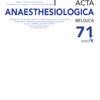An observational study to determine whether alignment of endotracheal tube indicator line with the vocal cords results in appropriate depth of intubation
endotracheal tube placement ; depth of endotracheal tube insertion ; oro-tracheal intubation ; vocal cords to carina distance
Published online: Jun 30 2020
Abstract
Background: Inappropriate endotracheal tube placement depth may be associated with complications.
Objective: To determine whether the accurate alignment of the indicator ring on the endotracheal tube at the level of the vocal cords, results in its appropriate placement.
Design: Prospective observational study.
Patients: 98 adult patients scheduled for general anesthesia with orotracheal intubation.
Interventions: The indicator band mark on the endotracheal tube was accurately placed at the vocal cords level under video-laryngoscope view. The tube length at the right upper incisor and the distance between its tip and the carina was measured using fibreoptic bronchoscope. Data to validate methods to predict insertion depth was collected and evaluated.
Main Outcome: To determine the distance between the tip of the endotracheal tube and the carina.
Results: The endotracheal tube tip depth was inap- propriate in 46.94% cases and was <3 cm above the carina in 41.64% cases. This difference in this distance was similar (p = 0.246) in the two genders. A correlation was noted between topographic length and insertion depth in females only (r2 = 0.201 and p = 0.001). The mean tracheal length was 12.66 + 1.35 cm in males and 12.04 + 1.26 cm in females.
Conclusion: We found a high incidence of endo- tracheal tube tip malposition despite the accurate placement of the indicator band at the vocal cords level. We suggest that international endotracheal tube design standards be defined and endotracheal tube manufacturers modify the standard intratracheal length.
